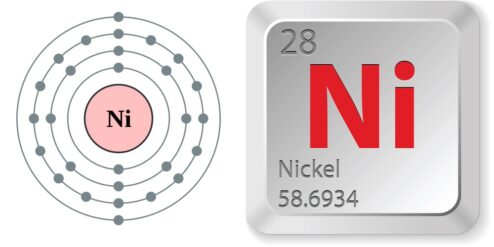Introduzione: Nickel is a naturally occurring, lustrous, silvery-white metallic element. It is the fifth most common element on earth and occurs extensively in the earth’s crust and core. Nickel, along with iron, is also a common element in meteorites and can even be found in small quantities in plants, animals, and seawater. While this element is primarily used for the production of stainless steel and other corrosion-resistant alloys, it is also a common component in certain types of jewelry, coins, and batteries. However, prolonged or excessive exposure to nickel can lead to a variety of health issues, including a specific type of dermatitis that is caused by nickel allergies.
Understanding the Basics: What is Nickel?
Nickel is a versatile element that is both magnetic and conductive. It is used in a wide range of applications, including the production of stainless steel, coins, rechargeable batteries, and special alloys. Nickel also plays a crucial role in biology, as certain enzymes require nickel to function properly. However, despite its many uses, nickel is also a known allergen and can cause health problems in individuals who are sensitive to it. Prolonged exposure to nickel can lead to a variety of health issues, including skin disorders, lung cancer, and cardiovascular disease.
Nickel Exposure: How Does it Occur?
Exposure to nickel can occur in a variety of ways. Occupational exposure is common in industries that process or use nickel, such as mining, smelting, welding, and casting. In these industries, workers may inhale nickel dust or fumes, or come into direct skin contact with nickel-containing materials. However, exposure can also occur outside of occupational settings. For example, nickel is a common component in jewelry, coins, eyeglasses frames, and certain types of clothing fasteners. Individuals can be exposed to nickel by wearing these items, particularly if they cause prolonged skin contact. Additionally, certain foods and drinks can contain small amounts of nickel, which can lead to oral exposure.
Nickel and the Human Body: An Overview
When nickel enters the body, it can affect several different systems. The respiratory system is often the first to be affected, as inhaled nickel can cause bronchitis, reduced lung function, and lung cancer. The skin is also commonly affected, as direct skin contact with nickel can cause dermatitis, also known as “nickel itch.” Additionally, ingested nickel can affect the gastrointestinal system, causing symptoms such as nausea, vomiting, and diarrhea. In severe cases, nickel can also affect the heart and kidneys, leading to cardiovascular disease and kidney damage.
Nickel-Induced Diseases: A Comprehensive Analysis
The most common disease caused by nickel exposure is allergic contact dermatitis. This condition occurs when the immune system reacts to nickel on the skin, causing symptoms such as redness, itching, swelling, and blisters. Prolonged or repeated exposure to nickel can also lead to more serious health issues, such as lung cancer and cardiovascular disease. Studies have shown that workers in industries that process or use nickel have a higher risk of developing these diseases. Additionally, there is some evidence that nickel exposure may be linked to reproductive toxicity and developmental problems in children.
Case Study: Dermatitis from Nickel Exposure
A common example of a disease caused by nickel exposure is a condition known as “nickel dermatitis” or “nickel allergy.” This condition is a form of contact dermatitis that occurs when the skin comes into direct contact with nickel. Symptoms can include redness, itching, swelling, and blisters. In severe cases, the skin may crack or bleed. Nickel dermatitis is particularly common among individuals who wear nickel-containing jewelry or clothing items. For these individuals, simply avoiding contact with nickel can often help to manage symptoms.
Preventive Measures: Reducing Risk of Nickel-Related Diseases
There are several ways to reduce the risk of developing diseases related to nickel exposure. For individuals who work in industries that use or process nickel, wearing protective clothing and using proper ventilation can help to limit exposure. For individuals who are sensitive to nickel, avoiding contact with nickel-containing items can help to prevent allergic reactions. This can include choosing jewelry and clothing items that are free of nickel, or using protective coatings on items that come into direct contact with the skin. Additionally, eating a balanced diet can help to ensure that the body gets enough iron, which can help to reduce the absorption of nickel.
Conclusioni: Nickel is a versatile and widely used element, but it can also pose significant health risks. Prolonged or excessive exposure to nickel can lead to a variety of diseases, including dermatitis, lung cancer, and cardiovascular disease. However, by taking appropriate preventive measures, it is possible to reduce the risk of these diseases and protect your health.
Per approfondire:
- "Nickel." National Institute for Occupational Safety and Health (NIOSH). This source provides comprehensive information on the health effects of nickel exposure, as well as guidelines for occupational safety.
- "Nickel Allergy." Mayo Clinic. This source provides detailed information on nickel allergies, including symptoms, causes, and treatment options.
- "Nickel in Drinking-water." World Health Organization (WHO). This source provides information on the health effects of ingesting nickel through drinking water.
- "Nickel Carcinogenesis." National Institutes of Health (NIH). This source provides a detailed analysis of the link between nickel exposure and cancer.
- "Nickel." Agency for Toxic Substances and Disease Registry (ATSDR). This source provides a comprehensive overview of nickel, including its uses, health effects, and guidelines for exposure.


